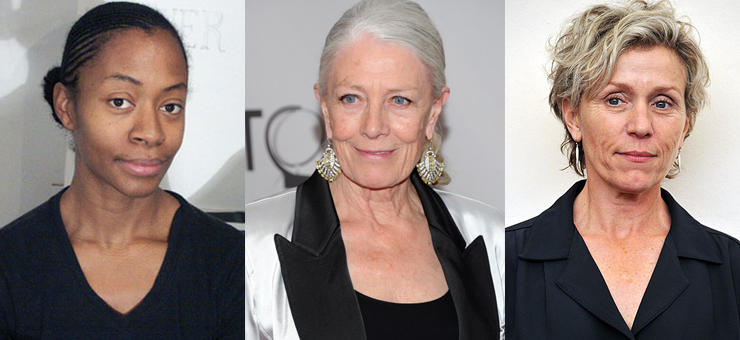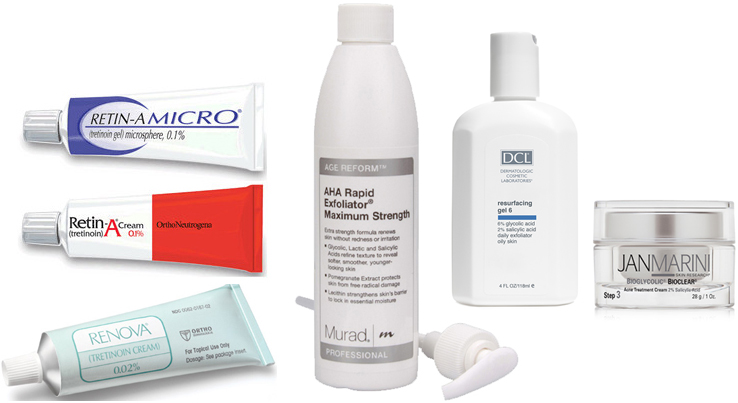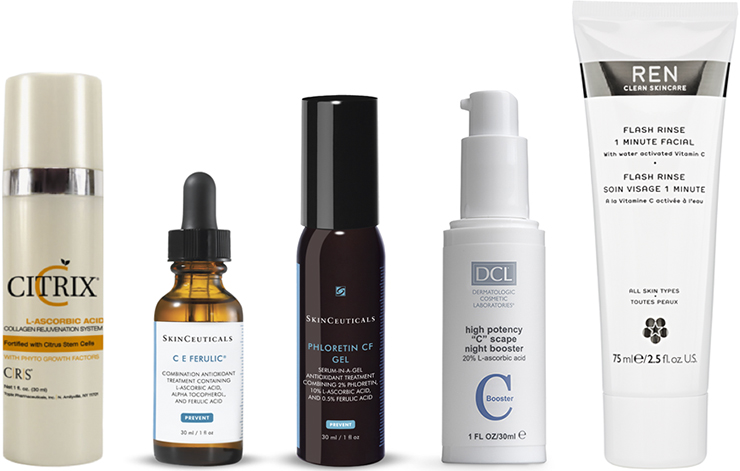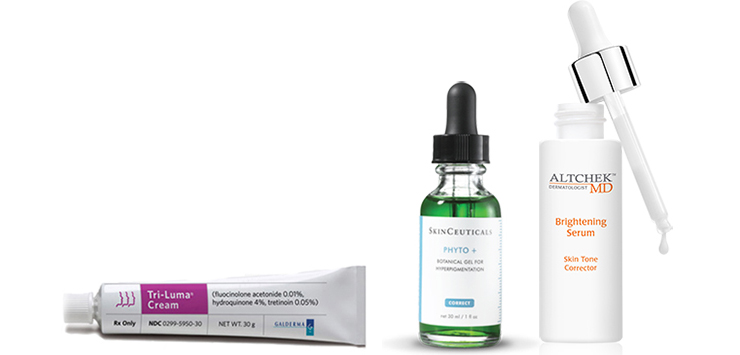ENTER YOUR EMAIL TO RECEIVE OUR WEEKLY NEWSLETTER
At Home Face Rejuvenation Recommended by Experts
Powerhouse ingredients and products that work—no appointment needed!
By Linda Dyett

Proudly displaying a foundation-free face to the world are, Artist Kara Walker (Photo: Jaya Howey), Vanessa Redgrave (Photo: Charles Sykes), and Francis McDormand (Photo: Camilla Morandi).
. . . . . . . . . . . .
Updated Sept. 5, 2022
What do urban women want from their faces? That’s the question I recently posed to a cross-section of New York women over age fifty. Typical answer? To present to the world healthy, clean-scrubbed, foundation-free skin.
“Luminosity—skin glow—is what’s coveted most these days,” says Douglas Altchek, Clinical Professor of Dermatology at Mount Sinai’s Icahn School of Medicine. “There’s no reason that women in their fifties and beyond cannot look radiant if they actively seek simple and effective regimens to protect and correct their skin. These regimens are not a substitute for completely invasive techniques, but they can improve wrinkles, brown spots and luminosity and they will reduce sagging to some degree. If used consistently, they will keep women looking vibrant well into their ninth decade.”?
That’s right, into your 90s! Have I got your attention?
These days, a slew of home-use skin rejuvenation products have sprung up in a vast price range. Some seriously rejuvenate the skin. Others—even thousand dollar beauty creams—are a waste of money. Below is a hype-free rundown of today’s most effective non-invasive, at-home routes to healthier, clearer, smoother, more buoyant skin, based on interviews with medical and scientific experts. Most of the non-prescription products below are “cosmeceuticals”? rather than beauty-oriented cosmetics; they are typically available online, at dermatologists’ offices and select department and specialty stores. With a few exceptions, the focus is on the powerhouse treatments that emerged in the 1980s and ’90s and then eclipsed in recent years by questionable lotions and potions—identified in “Rejuvenators that May—or May Not—Live Up to Their Hype”? section at end. The ingredients and products that follow make a sustained, noticeable, therapeutic difference. But since some can also damage certain skin, check with your dermatologist before trying them. If the product is not available for sale on the company website, you can find it on Amazon.
TRETINOIN
Most skin rejuvenators clear off dead and damaged surface cells, setting off a wound-healing response that triggers new collagen production. Not so with tretinoin. A prescription drug, (and key ingredient in Retin-A, Retin-A Micro, Renova, Tri-Luma, Atralin and Avage) introduced as an acne treatment over 40 years ago, this vitamin A derivative came to the fore in the ’80s as a fine-line and wrinkle remover. It also restores radiance, tightens pores and removes mottling. “Tretinoin pushes the skin into overdrive,”? says the molecular biologist Daniel Yarosh, PhD, a skin-ingredient and DNA repair expert. “It accelerates gene function, leading to increased collagen production and more buoyant cells. No other skin rejuvenation therapy has been proven better in large-scale double-blind testing at removing fine wrinkling, lightening discolorations, and smoothing out rough skin.”?
Tretinoin doesn’t produce immediate stinging or tingling—typical signals that rejuvenation is at work. But after a couple of days the skin acquires a velvety touch and more even tone. After a few months of regular use, fine-lines are removed, brown spots are lightened, and a new plumpness and firmness become evident. Tretinoin also permits better penetration of other powerhouse ingredients. This is the Slow Boat to China approach. But it works. Over the years, tretinoin has gotten a bad rap for making the skin more susceptible to sunburn and causing irritation, flaking, and dryness. But these can be minimized, according to Jessica Krant, Assistant Clinical Professor of Dermatology at SUNY Downstate Medical Center. She recommends using a moisturizer immediately after nighttime face-washing, then wait an hour before applying tretinoin. Or alternatively, apply a moisturizer immediately before or after the tretinoin. Panta Rouhani Schaffer, Clinical Assistant Professor of Dermatology at NYU’s Langone School of Medicine, typically has patients use tretinoin “three nights per week, and for those who want to push the limit and build up their tolerance to redness and flakiness, nightly.”?

Glycolic Acid and Other Alpha Hydroxy Acids
Glycolic acid, made from sugar cane, is the gold standard in home-use chemical exfoliants. An instant-gratification potion, it has set a high bar for other anti-agers ever since its 1980’s debut as the prime alpha hydroxy acid (mainly derived from fruits and milk), and it is likely to produce an immediate sting and the kind of rosy glow that typically comes from a vigorous aerobic workout or lengthy facial. Use it a couple of times a week and that glow remains. As with its sibling AHAs (lactic, citric, and mandelic acids), glycolic works by burning off dead and damaged surface cells. This triggers new collagen production, plumper, less crepe-paper-like skin, and fewer fine lines, acne scars, and discolorations.
Dr. Schaffer, for one, cautions patients to wash their faces and pat thoroughly dry before using a glycolic acid product, noting that redness, burns, rashes, and blistering can result. But even so, she continues, AHAs are “preferred for exfoliation over the use of microbeads, scrubs, and harsh handheld brushes that will irritate and strip the skin of natural oils and do more harm than good.”?
Shown above:
Murad AHA Rapid Exfoliator Contains glycolic, lactic, and salicylic acids. (Salicylic, from willow bark, is a beta hydroxy acid—a stronger, potentially more irritating cousin of the alphas.
DCL AHA Revitalizing Gel Comes in 10, 15, and 20 percent alcohol-based concentrations. Packs a serious punch.
Jan Marini Bioglycolic Bioclear Cream Hydrates as well as exfoliates.

VITAMIN C
Officially it’s a free-radical-fighting antioxidant that wards off—and may reverse—sun and environmental damage, but what places vitamin C in the pantheon of skin rejuvenators are several unique powers. “It switches on the genes that make collagen, stimulating enzymes that keep pumping out collagen and binding them into cables, and it stops enzymes that degrade collagen,”? says Dr. Yarosh. It also has lightening powers.
The trick is finding the right C. This volatile nutrient comes in several forms in skincare products, most of which degrade fairly quickly. The one to look for is stabilized L-ascorbic acid—typically combined with other ingredients that keep it fresh and enhance its powers. It’s likely to produce an immediate warming and gentle tingling sensation, and after a few days a new firmness and plumpness that will increase over time. When choosing a C product, make sure L-ascorbic acid is high on the ingredients list.
Shown above:
Citrix CRS L-Ascorbic Acid Serum 20% C in a smooth silicone base. Packaged in an airless pump dispenser that ensures penetration. In 10, 15, and 20 percent formulations. (See Topix Pharmaceuticals)
SkinCeuticals CE Ferulic 15% C in a liquid base, combined with ferulic acid (which acts as a stabilizer and increases C’s sun protection). For daytime use.
SkinCeuticals Phloretin CF Gel 10 % C, ferulic acid, and phloretin, derived from tree bark—a penetration enhancer that regulates pigment. For daytime use.
DCL High Potency “C”? Scape Night Booster 20% L-ascorbic acid, time-released, silicone-based, by DCL Skin Care
REN Flash Rinse 1 Minute Facial An innovative mask combining C with silica granules. Produces immediate warmth and radiance that livens up and velvetizes the complexion for over a day.)

LIGHTENERS
Not so long ago, the term for targeting brown spots and areas of mottling was lightening, accomplished with a bleaching cream. Today, lightening’s scope has expanded to encompass brightening and general rejuvenating. The ultimate lightener is hydroquinone, a chemical that curbs the skin’s pigment production. Available in over-the-counter as well as prescription strengths, hydroquinone is desirably fast-acting, but can be irritating. After several months’ use, many doctors advise switching to an alternate lightener.
For instance, tretinoin, alpha hydroxy acids, and L-ascorbic acid have their own built-in lightening powers. Also getting attention these days are botanicals—most notably bearberry-derived arbutin (which closely resembles hydroquinone); kojic acid (found in mushrooms); dried mulberry root and leaves; and azelaic acid (from wheat, rye, and barley). “Clinical studies show that these ingredients perform as well as or better than hydroquinone,”? says Dr. Yarosh. They’re usable over longer periods of time, and may prove particularly effective when combined with one another.
Lighteners can cause discoloration, especially on dark skin. Dr. Krant, who’s seen too many patients with “rashes or unintended white or dark patches after trying to self-prescribe a home plan,”? advises asking your dermatologist for a lightening routine for your skin type.
Shown above:
Tri-Luma Cream A prescription blend of tretinoin, hydroquinone and an anti-inflammatory steroid.
SkinCeuticals Phyto + A Serum with kojic acid and arbutin.
Altchek MD Brightening Serum With L-ascorbic acid and mulberry root.
HAIR RESTORER
A luminous complexion deserves an accompanying head of plentiful hair—which brings us to brand new Women’s Rogaine 5% Minoxidil Topical Aerosol, below. (Minoxidil, originally used to treat high blood pressure, prevents thinning and spurs new hair growth.) This is high-octane Rogaine in an aerosol can that creates a non-drippy foam adept at sinking into the scalp. “In clinical testing of over 700 women, more than 80 percent grew hair over 12 weeks,”? says Doris Day, clinical associate professor of dermatology at the New York University Langone Medical Center.

LASH ENHANCER
Prescription Latisse (the same formula as Lumigan, a glaucoma medication) above, has been proven to grow longer, fuller, darker eyelashes. It takes a few weeks to start seeing results, but when you do—they’re unmistakable. There is some evidence that Latisse, in combination with an allergy and asthma medication that blocks a substance preventing hair growth, may also be beneficial for restoring hair on top of the head.
REJUVENATORS THAT MAY—OR MAY NOT—LIVE UP TO THEIR HYPE
In the beauty industry, hope-in-a-jar springs eternal—especially today, when ingredients such as retinol and antioxidants are widely reputed, and taken as chapter and verse, to have therapeutic powers like those of Retin-A, Botox, and injectable fillers.
But do they seriously rejuvenate the skin? Maybe, but not necessarily, and certainly not as effectively as the ingredients above. Let’s take a look.
Retinol: Tretinoin’s precursor, retinol, is pure vitamin A, found in many skincare products these days. Its claim to fame is being a gentler, less irritating, non-prescription alternative to tretinoin. “Retinol can act as a physical barrier to dryness and also maintain a number of immune cell types that can benefit aging and healing of the skin,”? says Dr. Altchek. A recent study performed by SkinMedica, a pharmaceutical company that produces retinol products, found that in high concentrations it can be as effective as tretinoin. (SkinMedica Retinol Complex and Roc Retinol Correxion are two such high-potency products—though retinol concentration in most cosmetics tends to be low.)
“Retinol is a great starting point,”? proposes Dr. Schaffer, who then cautions that “to get the dermal benefit, you need the cellular active and bioavailable retinoic acid.”? And as Dr. Yarosh points out, “retinol is a step down in potency. It’s unstable, it readily degrades in sunlight, and by the time it gets metabolized in the skin into retinoic acid, practically none is left.”?
The question remains: Why use a retinol product, which may or may not be effective, when tretinoin is guaranteed to be therapeutic—and can be diluted with moisturizer while tolerance to it is built up?
Antioxidants: Green tea, milk thistle, pomegranate and a host of other botanicals are classified as antioxidants, defined as having free-radical fighting powers that prevent and correct oxidative damage. When consumed in fruits and vegetables, many say they protect the body—and the skin—from the damaging effects of sunlight, pollutants, smoking, and stress. As Dr. Schaffer puts it, “our skin is very much a representation of what is going on inside.”? But in skincare products, the evidence for antioxidants’ effectiveness is unclear. Not only is it tricky proving preventive protection, but keep in mind that antioxidants are produced by plants, and their effectiveness varies from harvest to harvest, with a poor crop meaning lower potency.
The experts are divided on antioxidants’ effectiveness. On the pro side: “Antioxidants such as resveratrol and green tea have a substantial effect if used over a period of time,”? says Dr. Altchek. Adds Dr. Schaffer, “by applying an antioxidant immediately before sunblock, you are helping prevent any ultraviolet radiation that may get through from doing damage to your skin.”? Dr. Krant sounds a note of caution: “Though it’s well known that dietary antioxidants protect against cellular oxidative damage, it’s less clear what the effect of any given cream is, due to the difficulty of proving the quality, concentration, and whether it really penetrates skin to the level necessary. Not that it doesn’t work. It’s just hard to prove.”? Dr. Yarosh, for one, maintains that “antioxidants have little or no effect on the overall formula.”?
Firming Creams: The beauty aisles have lately been chock-a-block with smoothing, firming, wrinkle-blurring creams, often touted as affordable quick-fix alternatives to Botox, Restylane and other injectable wrinkle fillers. The better-formulated among them do smooth out lines and lessen some wrinkles for a matter of hours—a cosmetic benefit. But do they have therapeutic benefits—like slowing wrinkle formation? None of the dermatologists I interviewed could offer comments here, pro or con.
But Dr. Yarosh, the ingredients expert, points out that “temporary wrinkle creams contain optical micro-beads that fill in the wrinkle and diffuse the light.”? In doing so, however, they also “reduce brightness and ‘glow.’”?
. . . . . . . . . . . .

WOMEN WHO DARE TO GO BARE (SOMETIMES, AT LEAST)
Beauty news flash: A growing number of women, especially those over age 50, have lately been going makeup-free, treating face paint with indifference or even disdain. Okay, some will flick on lipstick or eyeliner out of habit or for a deliberate swagger effect. But foundation, concealer, blush? Taboo. Even the new “invisible”? formulas are verboten. The seemingly brazen display of a nude complexion may well be the ultimate status symbol these days in fashionista circles, where makeup-free has become a look.
Why? A few reasons.
1) Many mature women are simply tired of the makeup routine and willing to bare their skin as a badge of confidence or laziness.
2) An unpainted face suits today’s informal clothing and hair styles.
3) An undone complexion is a disdainful urban response to the heavily made-up Desperate Housewives look.
4) High-maintenance types who’ve had their skin stretched, plumped, and lasered to perfection want to show it off au naturel. —L.D.
Women shown above: Actress Frances McDormand, Novelist Barbara Ehrenreich, U.S. Ambassador to the U.N. Samantha Power, American Vogue fashion director Tonne Goodman, Actress Vanessa Redgrave, Creative Director of American Vogue, Grace Coddington, Artist Kara Walker, Editor-in-chief of French Vogue Emmanuelle Alt, French chanteuse Francoise Hardy, Presidential historian Doris Kerns Goodwin, Human rights advocate Bianca Jagger, British style arbiter Jane Birkin, British fashion designer Margaret Howell, Managing Director of the International Monetary Fund Christine Lagarde, Artist, singer, songwriter Patti Smith.
. . . . . . . . . . . .
Linda Dyett’s articles on fashion, beauty, health, home design, and architecture have appeared in The New York Times, Washington Post, Monocle, Afar, New York magazine, Allure, Travel & Leisure, and many other publications.
You may enjoy more NYCitywoman articles by Linda Dyett and others:











